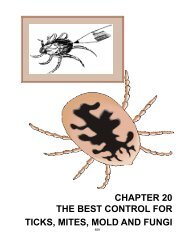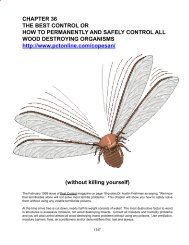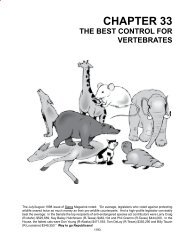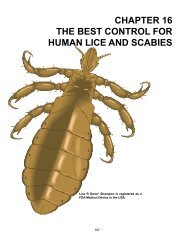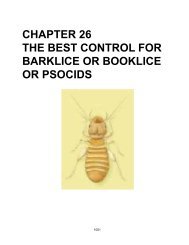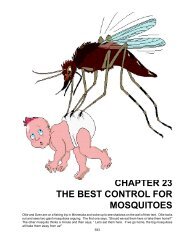1 kg of grain legumes. This provides protection upto six months from bruchids.Store Food - in air tight containers or in the refrigerator. Never allow any food to remain in the open.STP ® - Oil Treatment or Vaseline ® can be used to trap small insects.Straining Mixtures - Strain any of these mixes through multiple layers of cheesecloth and/or a disposablecoffee filter.Straw Mulches - Putting straw mulches under plants like watermelon and muskmelon prevents the fruit fromrotting from ground contact. <strong>The</strong> mulch also retards weed growth.Straws - Blowing through a straw will make roaches run from a crack. Straws can be used to make bait stationsand to trap earwigs.Stream of Water - will wash off aphids and spider mites from plants.String - Properly positioned - string (wire or dental tape) will keep birds off an area or roof. Most birds hate tohave anything rub against their legs when they are roosting. So nail two end brackets on either gable end (orwherever you see birds roosting) and string a piece of wire or waxed twine about 4” above the ridge. This simplecontrol works for most birds an is non-toxic and inexpensive.String Trimmers - mechanically manage weed problems and kill or injure some trees.Stripper - A little floor stripper in water provides quick insect control.Strobe Lights - Place a bright strobe light in dark areas where you have bats, birds, rats, squirrels, feral cats,raccoons, skunks, etc. in attics, storage buildings, barns, crawl spaces, etc., and watch them all leave in a fewhours or days. <strong>The</strong> pupils of their eyes can not tolerate that much exercise. <strong>The</strong> strobe light is also highly annoyingto people and pets, so make sure you can turn it off before you re-enter these areas. Caution: Strobe lightscan trigger seizures in people with photo sensitive epilepsy.Structural Heating - can be used to kill drywood termites, roaches, bed bugs and many other pests.Sugar - High concentrations of sugar, e.g., honey, will not allow the growth of bacteria. Cane sugar incorporatedinto soil at a rate of 5# per 100# of soil will kill all nematodes in 24 hours. (Some plants do not like sugar, soyou may need to flush the sugar out before planting.) Cut the top off a 2 liter plastic pop bottle, invert it insidethe bottle to make a “funnel” (secure it with duct tape). Pour sugar water, fruit juice or pop 2 - 3 inches in thebottom (with a few drops of soap or enzyme cleaner) to attract and kill hornets and wasps. Sprinkle fly paperwith granulated sugar and hang in trees, dumpsters, or wherever you want to trap hornets and wasps. Dissolve ateaspoon each of lemon juice, sugar and jam in a glass of water - pour the mixture in a can, with 2 - 3 (half-round)openings on each side - push the sharp edges inward - attracted to moisture and sweets, slugs will crawl in andbe killed by the acidic lemon juice. Half upturned grapefruit rinds will also kill slugs - the juice is acidic. Mix: 1part active yeast, 2 parts molasses and 1 part sugar. Mix the ingredients well. Drop a teaspoonful on severalsmall squares of white paper. Place the paper squares along ant trails where they will not be disturbed. Howdoes it work? <strong>The</strong> ants are attracted to the sugary feast and will consume it readily. <strong>The</strong> action of the yeast,however, will produce gas in their bellies which they cannot rid themselves of. <strong>The</strong>y essentially will pop. <strong>The</strong>best part of this method of pest control is that it utilizes no volatile poisons which could harm you or your family.A fruit tree spray can be made by dissolving 2 pounds of granulated sugar in 5 gallons of warm water. Let themixture stand for several hours and spray any fruit tree or grape or rose plant after a dormant oil spray. Mix 1/4cup of confectioner’s sugar and a tablespoon of borax with 2 tablespoons of water. Soak cotton balls in mixtureand place on low lids. Or mix 2 tablespoons boric acid, 2 tablespoons sugar and a cup of water. Soak papertowels, place on dishes (or in shallow screw-top jars with 6 - 8 holes punched in the lid), and set out for ants.Keep any and all borax controls out of reach of children and pets. Mixing baking soda with powdered sugarand applying to infested areas to control ants and/or roaches. Equal amounts of oatmeal flour and plaster ofParis or equal amounts of borax and brown sugar will kill roaches, but keep out of reach of children and/or pets.Combine 8 parts powdered rodent chow, 3 parts granulated sugar, and 1 part boric acid crystals. Add water462
to make the mix about the consistency for good mud pies and add green food coloring to avoid unintentionalmisuse as animal feed. Roll the mix into balls about 1 inch in diameter. Place balls of bait in locations used byroaches for raceways and harborage. <strong>The</strong> bait needs to be made up fresh every 3 months. Keep all borax,boric acid, or sodium borate baits out of reach of children and/or pets.Adding sugar or other sweet material to fertilizer tends to make the plant “too sweet” for insect pests to eat, sothey move on to the neighbor’s field.Sugar Apple - When the seeds and roots are extracted with ether, they are converted to a resinous substanceto make a contact poison for aphids. It is toxic and repellent to diamondback moth larvae. Hot-pressed andheat-extracted oils of seeds are highly toxic contact poisons to several pests.Sugar Substitutes - lilke Splenda ® and Equal ® kill insects when they are consumed by insects. Splenda ® attractsred-eyed fruit flies and is compounded with chlorine as a base. (Chlorinated water will also kill insects.) See theweb site located at http://www.proliberty.com/observer/2003<strong>11</strong>12.htm to see how dangerous Splenda ® is to you.Sulfur - can be used as a fungicide, acaricide and repellent; it will control mites, thrips, chiggers and severaldiseases in ornamental and fruit crops. Sulfur and naphthalene will repel several species of snakes. (<strong>The</strong>two-spotted mite is resistent to sulfur.) Sulfur, especially with a little lime, will control fungus. One of the firstPestisafes ® ; the Romans used it to fumigate/control roaches. Homer first mentions its use for pest control inabout 1000 B.C.E. About 2500 B.C.E. Sumerians first used sulfur to control pests. Sulfur acts by competingwith oxygen in the blood stream.Sulfuric acid (10% v/v) - has been used as a selective herbicide since the early 1900s when it was discoveredthat dicotledonous weeds would absorb the acid, whereas cereal grains (grass) etc., having a smooth, waxymonocotyledon surface would not. Be very careful not to touch any acid.Sun - Placing infested objects in black garbage bags and then setting them outside in the sun on a hot day willkill virtually any enclosed pest infestation.Sunburn “Cure” - Fill a pitcher or pail with equal parts of milk and ice. Soak enough washcloths or towels inthis to cover your sunburned skin and place them on affected areas for about 15 minutes. Repeat several timesover the next 24 hours. Cold milk protein soothes skin and helps draw out the heat.Sunny Location - Choose a sunny location away from large trees. Eight to ten hours of direct sunlight per dayare necessary for proper growth, flowering and fruiting of most vegetable and fruit crops. Sunlight also helps todry foliage and reduce many fungal and bacterial diseases.Super Slurper - has starch-based polymers that “drink” water up and turn it into a gel. It can dry wet books ina few minutes; stop mold growth that can begin in 48 hours. It can also be used as an alternative to vacuumfreeze-drying. Put some in powdered sugar as a bait and watch what happens. In dry areas it can be used asa tracking powder. Blow some into drywood termite colonies.Super Soaker ® - Model 2500 or another very powerful water gun or soaker or rechargeable fire extinguisherwith constant pressure can be used to discipline dogs and cats and birds, “tree rats” and other nuisance wildlife,etc. Put diluted enzyme cleaners in the soaker and blast hornet nests and other pests.Surfactants (or surface-active agents) - Are slightly viscous, clear amber substances or colloids that work as(“magnetic”) cleaners and degreasers. Surfactants can be used as household, industrial and marine cleaners,personal hygiene products, insect repellents and insect, arachnid and bird pest control compounds. A micelleis a colloid, microscopic particle formed by an aggregation of small biodegradable molecules. Each moleculehas a hydrophilic (water-seeking) pole and a hydrophobic (water-repelling) pole. <strong>The</strong> hydrophobic poles attracteach other, forming the interior of the micelle and the hydrophilic poles form the outer surface. When a singlemicelle or surfactant molecule comes in contact with a hydrocarbon molecule (grease, oil, wax, binders, etc.),the hydrophobic center of the micelle or surfactant quickly bonds via homologous attraction to the hydrophobichydrocarbon site, locking it into a colloidal suspension, pulling the hydrocarbon into the micelle and lifting thehydrophobic hydrocarbon molecule from its original surface. This emulsification process easily penetrates highly463
- Page 1:
CHAPTER 11SAFE AND FAR MOREEFFECTIV
- Page 4 and 5:
pesticide poisons do - to them the
- Page 6 and 7:
American Beautyberry (Callicarpa am
- Page 8 and 9:
packets in 4 days or less. Aspartam
- Page 10 and 11:
Baking Soda - Baking soda or sodium
- Page 13 and 14:
Bioderivatives - are substances whi
- Page 15 and 16:
Bird feeders - will attract more th
- Page 17 and 18:
an abrasive action on the insect wh
- Page 19 and 20:
pathogens - volatiles produced duri
- Page 21 and 22:
ground, grain and stored product ap
- Page 23 and 24:
epels many insects, including flies
- Page 25 and 26:
een used medically since at least t
- Page 27 and 28:
Collateral Damage - When you spray
- Page 29 and 30:
Cottonseed Meal - is a source of ni
- Page 31 and 32:
Desiccants - Hot air, dehumidifiers
- Page 33 and 34:
Dogs - have been trained to sniff o
- Page 35 and 36:
elderberry leaves to protect them f
- Page 37 and 38:
controls pests and acts as a deodor
- Page 39 and 40:
contamination that no one can hones
- Page 41 and 42:
Chlorphyll Graphite Parrafin wax Wa
- Page 43 and 44:
Film Capsule - The plastic capsule
- Page 45 and 46:
Repel roaches with bay leaves and e
- Page 47 and 48:
person in your house, but you’ll
- Page 49 and 50:
slender sickle-shaped jaws. They ap
- Page 51 and 52:
epellent that contains only natural
- Page 53 and 54:
infusion of pignut leaves, rubbed o
- Page 55 and 56:
Human Hair - cut in small pieces wi
- Page 57 and 58:
Insect Diseases - In 1836, Agostino
- Page 59 and 60:
Irrigation Management - Improper ir
- Page 61 and 62: lack cutworms.Laxatives - Chocolate
- Page 63 and 64: we die. Check out magnesium in Chap
- Page 65 and 66: Milk Thistle - is a proven detoxifi
- Page 67 and 68: Moon Flower (Datura ioxia) - Do not
- Page 69 and 70: Spotted knapweed begins producing c
- Page 71 and 72: Nothing - Doing nothing is a choice
- Page 73 and 74: fertilizers and sprays will normall
- Page 75 and 76: added to enzyme cleaners or when us
- Page 77 and 78: yellow to yellow crystalline solid
- Page 79 and 80: Aureolaria virginica (L.) Pennell.
- Page 81 and 82: Clematis vitalba L. (Honduras fish
- Page 83 and 84: Euphorbia bicolor Engelm. and Gray.
- Page 85 and 86: Justicia adhatoda L. (Adhatoda vasi
- Page 87 and 88: Momordica charantis L. (Balsam-pear
- Page 89 and 90: Piper nigrum L. (Black pepper).Stro
- Page 91 and 92: Sesamum indicum L. (S. orientale L.
- Page 93 and 94: Xanthorrhoea hastilis R. Br. (Black
- Page 95 and 96: Pomander - Repel moths and other in
- Page 97 and 98: y Safe Solutions at 1-888-443-8738
- Page 99 and 100: ight red and cover them with petrol
- Page 101 and 102: a wide variety of antioxidants call
- Page 103 and 104: Sawdust - Sawdust can be treated wi
- Page 105 and 106: lit charcoal in the tunnels would a
- Page 107 and 108: Active IngredientGeneric Name Trade
- Page 109 and 110: Sour Milk - sprays will loosen scal
- Page 111: Stay Calm - Take a deep breath amd
- Page 115 and 116: pesticides have never controlled or
- Page 117: Temperature - Increase or lower tem
- Page 120 and 121: in colder climates. The most fragra
- Page 122 and 123: and/or dehumidifiers, plumbing and
- Page 124 and 125: odents, scorpions, etc. to your bai
- Page 126 and 127: Oregano also contains four anti-ast
- Page 128 and 129: like colds, and headaches and spend
- Page 130 and 131: then estimated human population. Gi
- Page 132 and 133: “The choice, after all, is ours t
- Page 134: 484



